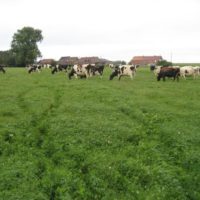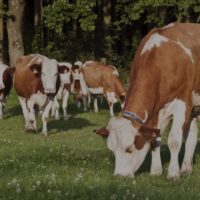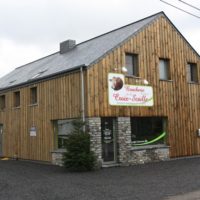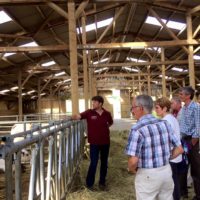Drone-supported management of a free ranging sheep herd in remote summer pastures
Practice abstract
Description
A small mountain farm in Ahrntal (South Tyrol, Italy) bases his economic activities in summer (June to September) on a small herd of about 30 breeding sheep (breed: Tiroler Bergschaf) and on renting two huts located at the summer pastures to tourists. The sheep are free ranging on mountain pastures (22 ha; 2000 to 2800 m a.s.l.) with limited view because of the rough terrain. They can even move to the other side of the mountain in Austrian territory. In the past, one person spent one whole day per week looking for the herd by feet, checking that no animals were missing and they were in good conditions. Two years ago, a second-hand drone (50 cm diameter, 4 kg weight) transmitting aerial images to a remote monitor was bought with a small investment of about 2,600 €. Since then, the herd is first localized by means of the drone starting from the huts and flying about 25 m above ground. The animals are counted, and the herd is visited only if necessary. This strongly reduces both the frequency of the control walks as well as the time to reach the animals by feet. The position of the herd is known in advance, whilst the frequency of the remote controls can be increased because of the small time effort needed to perform them. This allows also additional targeted walks to prevent the herd accessing topographically dangerous areas, which resulted in a reduced loss of animals due to accidents. The prerequisites for an effective use of the drone are a learning phase to be able to pilot the drone and a detailed knowledge of the flown area. Until now, there were no complaints of the tourists concerning the drone flying the area, but this may be expected to happen if more farmers adopt this innovation. The permissions to fly this kind of drone without sight contact with it must be verified as well.
Drohnengestütztes Management einer freilaufenden Schafherde auf abgelegenen Almweiden
Ein kleiner Hof im Ahrntal (Südtirol, Italien) stützt seine wirtschaftlichen Aktivitäten im Sommer auf eine kleine Herde von rund 30 Zuchtschafen (Rasse: Tiroler Bergschaf) und auf die Vermietung der zwei Almhütten an Touristen. Die Schafe weiden auf der Alm (22 ha; 2000-2800 m u.d.M.) frei und können sogar auf die andere Seite des Berges ins österreichische Gebiet gelangen. In der Vergangenheit verbrachte eine Person einen ganzen Tag pro Woche damit, die Herde zu Fuß zu suchen, die Tiere zu zählen und ihren Zustand zu überprüfen. Vor zwei Jahren wurde mit einer kleinen Investition von ca. 2.600 € eine gebrauchte Drohne (50 cm Durchmesser, 4 kg Gewicht) gekauft, die Luftbilder auf einen Remote-Monitor überträgt. Seitdem wird die Herde zunächst mit Hilfe der Drohne vom Almgebäude aus lokalisiert. Die Drohne fliegt etwa 25 m über dem Boden. Die Tiere werden gezählt und die Herde nur bei Notwendigkeit aufgesucht. Dadurch wird sowohl die Anzahl der Kontrollgänge zu Fuß als auch die Zeit, die benötigt wird, um die Tiere zu erreichen, stark reduziert. Denn die Position der Herde ist im Voraus bekannt. Das ermöglicht häufigere Kontrollen aus der Ferne und die Möglichkeit, die Herde rechtzeitig zurückzuholen, wenn sie topographisch gefährliche Bereiche ansteuert. Der Verlust von Tieren wurde dadurch stark verringert. Voraussetzungen für einen effektiven Einsatz der Drohne sind eine Lernphase, um die Drohne steuern zu können, und detaillierte Kenntnisse des beflogenen Gebietes. Bislang gab es keine Beschwerden der Touristen über die fliegende Drohne. Das könnte sich aber ändern, wenn mehr Bauern diese Innovation übernehmen. Die Berechtigung, um mit dieser Art von Drohne außerhalb des Blickfeldes fliegen zu dürfen, muss überprüft werden.
Additional information
| Farming system | organic farming |
|---|---|
| Domains of innovation | machinery, tools |
| Main types of animal | meat sheep |
| Country | Italy |
| Product type | Practice abstract |
| Language | English, German |




